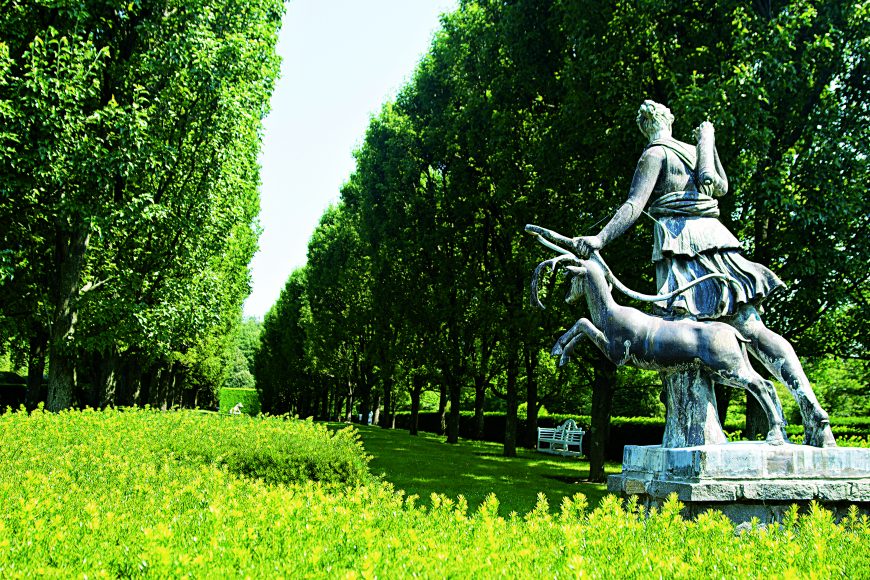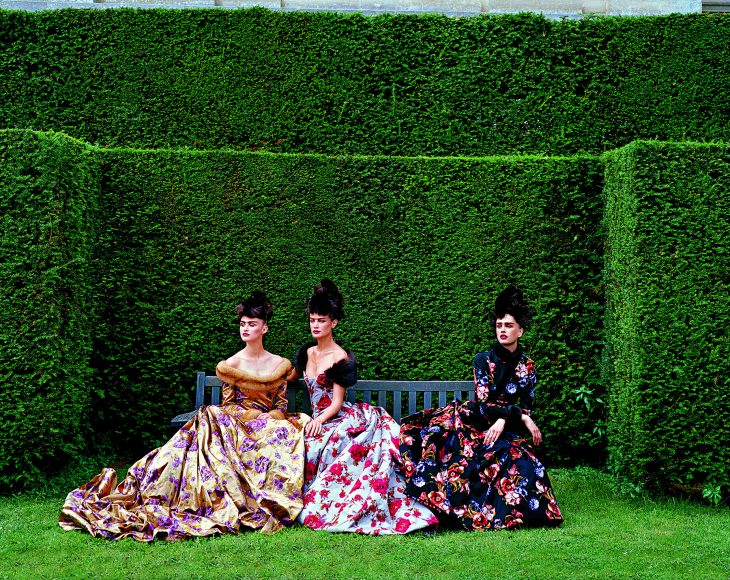Perhaps it is the proud Latino in him or the fact that he was born on the Cancer-Leo cusp, the sign of those who know how to feather their beds and make a statement. But there is a luxuriousness to an Oscar de la Renta creation – an elegance, glamour, drama, ornamentation, attention to detail, command and sense of completion. On Page 47 of Assouline’s new “Oscar de la Renta: The Style, Inspiration, and Life of Oscar de la Renta” (207 pages, $125), model Karlie Kloss comes at us like a fiery flamenco dancer – shades of Oscar’s sojourn in Spain, working for Balenciaga – her hands gathering folds of brilliant red satin before her, her creamy lace top hinting at décolletage while mirroring the voluptuous line of her white chandelier earrings.
Turn now to page 95 where a revelatory Hillary Clinton poses for Vogue in wine-colored velvet in the White House’s Red Room. She looks as if she’s been painted by David.
What these two images have in common are breathtaking looks for real women – the fitted bodice underscoring breasts, the flaring, bell- and ball-shaped skirts suggesting the curvaceous delights beneath. Not for Oscar the minimalists or skinny minnies, the boyish figures beloved by misogynists and sadists. But then, he was the devoted son of a strong mother and grandmother – Maria Antonia and Juana Fiallo; the attentive kid brother to five sisters; the admirer of his uncle’s Russian equestrian mistress, who fed his imagination with stories of the far world; the adoring husband of the incandescent Françoise de Langlade (onetime French Vogue fashion editor, who died of breast cancer in 1983) and the equally incandescent Annette; stepfather of Annette’s daughters Beatrice and Eliza. (He’s also the stepfather of Annette’s son Charlie – not to mention father to his own son, Moises.)
So Oscar knows women – and he knows what they want. Indeed, he championed ready-to-wear in the 1950s when hardly anyone in fashion knew what that was. No wonder he has had the confidence of female icons ranging from the Duchess of Windsor to Oprah Winfrey.
Should it surprise, then, that the convivial Oscar and the quiet-loving Annette bring their complementary Oscar- and Annette-ness to their three homes (in Manhattan, Kent, Conn., and his native Dominican Republic)? These teem with texture and pattern – the butterfly wallpaper and drapes in Annette’s Kent bath alone are swoon-worthy.
So, too, are the gardens, for Oscar and Annette are passionate, constant, blue-jeaned, pick-up-a-spade, down-on-your-hands-and-knees gardeners.
Nowhere is that more evident than at their country retreat, Brook Hill Farm in Kent, where Sarah Mower writes the couple have transformed the “tumbledown clapboard house and disused stables” and especially its gardens into “one of the most stunningly elegant private sanctuaries in America.”
Oscar and Françoise bought the property in the 1970s for its stunning views of undulating hills and forests. In the book, he acknowledges that when he married Annette, she had the architecturally superior country home, a beautiful Federal-style place in Katonah. But Brook Hill’s garden potential convinced her that they should sell the Katonah house and focus on the Connecticut property, whose gardens were originally designed for Oscar and Françoise by Russell Page. He did The Frick Collection’s garden across the street from where Oscar and Françoise lived in Manhattan.
Page believed that a garden is a room. So, Oscar says in the book:
“First, I planted a wall of yew around our pool; this eventually became our very first ‘room,’ where I have only late-blooming white flowers. The second is what used to be a parking area, and the third – my favorite – is what I call ‘my secret garden.’ It was initially intended as a rose garden and was built in a space 50 feet by 50 feet and divided into four planting areas by a brick path. It’s a paradise.”
One that is filled with honeysuckle, Alba roses, Artemisia and iris siberica. Diana, the Roman goddess of the hunt – in Greek mythology, Artemis – stands watch over pear trees. (She also turns up in a tabletop Augustus Saint-Gaudens incarnation in the couple’s Park Avenue apartment.) There’s also a henhouse on the property and plenty of space in which Annette’s rescue Norfolk terriers can play.
“A garden,” Oscar observes, “is probably the most pure and spiritual of joys – a communion with nature and beauty in their most simple and fundamental forms. It is an experience that needs to be lived at every instant. In a garden, one cannot reflect on something bad. What is truly wonderful is that it teaches you a lesson about life’s continuity. In a sense, a garden is a fragile vision that can quickly disappear out of neglect, but with constant work and tender love, it can preserve beauty forever.”
Oscar confesses in the book that he thought he would never have a garden, moving as he has from Madrid to Paris to New York in a career that has blossomed with each decade. Yet in a sense he was born for a garden. In his native Santo Domingo, he cherished the mango tree in the family garden, along with the hibiscus and tuberose. The ylang-ylang tree in the square still has a Proustian effect on him, the scent anywhere transporting him back there, back in time, so much so that ylang-ylang was an ingredient in his first fragrance, Oscar (1977).
At his Dominican home of Punta Cana on the Caribbean, Oscar indulges what Mower describes as “the languid riot of orchid, frangipani, tuberose, oleander, and hibiscus,” which “speak to his sense of color and pattern.”
It’s there that an equally important aspect of Oscar, the humanitarian, is thrown into particularly sharp relief. There he adopted Moises after losing Françoise and there he started La Casa del Niño – a school, orphanage and day care center that serves 1,200 children through eighth grade. There’s also a program for disabled youngsters.
“Oscar is a man of profound humanity, who demonstrates grace under adversity and who supports those in need without hesitation,” Vogue editor Anna Wintour writes in the book’s foreword.
Perhaps Oscar is a gardener, then, as God intended Adam to be: He is a cultivator of life.



